Molecular Prevalence and Phylogenetic Analysis of Anaplasma spp. in Goats from Adana, Türkiye
Simple Summary
Abstract
1. Introduction
2. Materials and Methods
2.1. Collection of Blood Samples from Goats and DNA Extraction
2.2. Detection of Anaplasma spp. by 16S rRNA PCR
2.3. Investigation of A. phagocytophilum by the Nested-PCR Method
2.4. Investigation of A. ovis by the msp4 Nested-PCR Method
2.5. Investigation of A. capra by the gltA Nested-PCR Method
2.6. Sequencing and Phylogenetic Analysis
2.7. Statistical Analysis
3. Results
4. Discussion
5. Conclusions
Author Contributions
Funding
Institutional Review Board Statement
Informed Consent Statement
Data Availability Statement
Acknowledgments
Conflicts of Interest
References
- Ceylan, O.; Xuan, X.; Sevinc, F. Primary Tick-Borne Protozoan and Rickettsial Infections of Animals in Turkey. Pathogens 2021, 10, 231. [Google Scholar] [CrossRef] [PubMed]
- Altay, K.; Erol, U.; Sahin, O.F. Anaplasma capra: A new emerging tick-borne zoonotic pathogen. Vet. Res. Commun. 2024, 48, 1329–1340. [Google Scholar] [CrossRef] [PubMed]
- Yessinou, R.E.; Koumassou, A.; Galadima, H.B.; Nanoukon-Ahigan, H.; Farougou, S.; Pfeffer, M. Tick Diversity and Distribution of Pathogen in Ticks Collected from Wild Animals and Vegetation in Africa. Pathogens 2025, 14, 116. [Google Scholar] [CrossRef]
- Lysholm, S.; Ådén, F.; Aspán, A.; Högberg, A.; Wensman, J.J.; Omazic, A. Presence of Anaplasma spp. and Their Associated Antibodies in the Swedish Goat Population. Animals 2023, 13, 333. [Google Scholar] [CrossRef]
- Zobba, R.; Murgia, C.; Dahmani, M.; Mediannikov, O.; Davoust, B.; Piredda, R.; Schianchi, E.; Scagliarini, A.; Pittau, M.; Alberti, A. Emergence of Anaplasma Species Related to A. phagocytophilum and A. platys in Senegal. Int. J. Mol. Sci. 2022, 24, 35. [Google Scholar] [CrossRef] [PubMed]
- Erol, U.; Şahin, Ö.F.O.F.; Altay, K. Molecular Survey of Anaplasma phagocytophilum and Related Strains in Sheep and Goats from Sivas; with a High Prevalence of Anaplasma phagocytophilum-like 1. Turkiye Parazitol. Derg. 2022, 46, 293–300. [Google Scholar] [CrossRef]
- Miranda, E.A.; Han, S.W.; Cho, Y.K.; Choi, K.S.; Chae, J.S. Co-Infection with Anaplasma Species and Novel Genetic Variants Detected in Cattle and Goats in the Republic of Korea. Pathogens 2021, 10, 28. [Google Scholar] [CrossRef]
- Wei, W.; Li, J.; Wang, Y.W.; Jiang, B.G.; Liu, H.B.; Wei, R.; Jiang, R.R.; Cui, X.M.; Li, L.F.; Yuan, T.T.; et al. Anaplasma platys-Like Infection in Goats, Beijing, China. Vector Borne Zoonotic Dis. 2020, 20, 755–762. [Google Scholar] [CrossRef]
- Li, H.; Zheng, Y.C.; Ma, L.; Jia, N.; Jiang, B.G.; Jiang, R.R.; Huo, Q.B.; Wang, Y.W.; Liu, H.B.; Chu, Y.L.; et al. Human infection with a novel tick-borne Anaplasma species in China: A surveillance study. Lancet Infect Dis. 2015, 15, 663–670. [Google Scholar] [CrossRef]
- Kocan, K.M.; Blouin, E.F.; Barbet, A.F. Anaplasmosis control. Past, present, and future. Ann. N. Y. Acad. Sci. 2000, 916, 501–509. [Google Scholar] [CrossRef]
- Çakan, H.; Yilmaz., K.T.; Düzenli, A. First comprehensive assessment of the conservation status of the flora of the Çukurova Deltas, southern Turkey. Oryx 2005, 39, 17–21. [Google Scholar] [CrossRef]
- Yang, J.; Liu, Z.; Niu, Q.; Liu, J.; Han, R.; Liu, G.; Shi, Y.; Luo, J.; Yin, H. Molecular survey and characterization of a novel Anaplasma species closely related to Anaplasma capra in ticks, northwestern China. Parasites Vectors 2016, 9, 603. [Google Scholar] [CrossRef] [PubMed]
- Yan, Y.; Lu, C.; Gong, P.; Pei, Z.; Peng, Y.; Jian, F.; Wang, R.; Zhang, L.; Qi, M.; Ning, C. Molecular detection and phylogeny of Anaplasma spp. closely related to Anaplasma phagocytophilum in small ruminants from China. Ticks Tick Borne Dis. 2022, 13, 101992. [Google Scholar] [CrossRef]
- Torina, A.; Agnone, A.; Blanda, V.; Alongi, A.; D’Agostino, R.; Caracappa, S.; Marino, A.M.; Di Marco, V.; de la Fuente, J. Development and validation of two PCR tests for the detection of and differentiation between Anaplasma ovis and Anaplasma marginale. Ticks Tick Borne Dis. 2012, 3, 283–287. [Google Scholar] [CrossRef]
- Tamura, K.; Stecher, G.; Kumar, S. MEGA11: Molecular evolutionary genetics analysis version 11. Mol. Biol. Evol. 2021, 38, 3022–3027. [Google Scholar] [CrossRef]
- Küçükbaş Hayvan Varlığında Avrupa Birincisiyiz. Available online: http://www.turktarim.gov.tr/Haber/416/kucukbas-hayvan-varliginda-avrupa-birincisiyiz (accessed on 10 April 2025).
- Rakamlarla Koyun Keçi. Available online: http://turkiyekoyunkeci.org/tr/RakamlarlaKoyunKeci (accessed on 10 April 2025).
- Aktas, M.; Özübek, S. Anaplasma ovis genetic diversity detected by major surface protein 1a and its prevalence in small ruminants. Vet. Microbiol. 2018, 217, 13–17. [Google Scholar] [CrossRef]
- Rahman, M.; Faruque, M.R.; Rahman, M.M.; Chowdhury, M.Y.E. Epidemiology and molecular detection of Anaplasma spp. in goats from Chattogram district, Bangladesh. Vet. Med. Sci. 2022, 8, 1240–1249. [Google Scholar] [CrossRef] [PubMed]
- Dumanli, N.; Altay, K.; Aktaş, M. Keneler ve kenelerle taşınan hastalıklar. Manas J. Agric. Vet. Life Sci. 2016, 6, 45–54. [Google Scholar]
- Dumic, I.; Person, E.; Igandan, O.; Adetimehin, O.; Nordstrom, C.W.; Williams, C.; Shweta, F. Anaplasma phagocytophilum Community-Acquired Pneumonia: Case Report and Literature Review. Microorganisms 2023, 11, 1483. [Google Scholar] [CrossRef]
- Atif, F.A.; Ullah, S.; Cossío-Bayúgar, R.; Kashif, M.; Khan, A.U.; Wu, W.F. Molecular Epidemiology, Seasonality and Phylogenetic Investigations of Anaplasma ovis in Small Ruminants from Diverse Agro-Climatic Regions of Punjab, Pakistan. Microorganisms 2023, 11, 2430. [Google Scholar] [CrossRef]
- Mahmoud, H.Y.A.H.; Tanaka, T.; Ali, A.O.; Emeish, W.F.A. Molecular detection and characterization of Anaplasma ovis, Theileria ovis, and Theileria lestoquardi in sheep and goats in Luxor, Egypt. BMC Vet. Res. 2024, 20, 260. [Google Scholar] [CrossRef] [PubMed]
- M’ghirbi, Y.; Oporto, B.; Hurtado, A.; Bouattour, A. First Molecular Evidence for the Presence of Anaplasma phagocytophilum in Naturally Infected Small Ruminants in Tunisia, and Confirmation of Anaplasma ovis Endemicity. Pathogens 2022, 11, 315. [Google Scholar] [CrossRef] [PubMed]
- Aouadi, A.; Leulmi, H.; Boucheikhchoukh, M.; Benakhla, A.; Raoult, D.; Parola, P. Molecular evidence of tick-borne hemoprotozoan-parasites (Theileria ovis and Babesia ovis) and bacteria in ticks and blood from small ruminants in Northern Algeria. Comp. Immunol. Microbiol. Infect. Dis. 2017, 50, 34–39. [Google Scholar] [CrossRef]
- Ben Said, M.; Belkahia, H.; Alberti, A.; Zobba, R.; Bousrih, M.; Yahiaoui, M.; Daaloul-Jedidi, M.; Mamlouk Mamlouk, A.; Gharbi, M.; Messadi, L. Molecular Survey of Anaplasma Species in Small Ruminants Reveals the Presence of Novel Strains Closely Related to A. phagocytophilum in Tunisia. Vector Borne Zoonotic Dis. 2015, 15, 580–590. [Google Scholar] [CrossRef] [PubMed]
- Naqid, I.A. Prevalence of Anaplasma ovis infection in Angora goats of Duhok province, Kurdistan region-Iraq. Iraqi J. Vet. Sci. 2017, 31, e73–e79. [Google Scholar] [CrossRef]
- Renneker, S.; Abdo, J.; Salih, D.E.; Karagenç, T.; Bilgiç, H.; Torina, A.; Oliva, A.G.; Campos, J.; Kullmann, B.; Ahmed, J.; et al. Can Anaplasma ovis in small ruminants be neglected any longer? Transbound. Emerg. Dis. 2013, 60 (Suppl. 2), 105–112. [Google Scholar] [CrossRef]
- Zhou, M.; Cao, S.; Sevinc, F.; Sevinc, M.; Ceylan, O.; Ekici, S.; Jirapattharasate, C.; Moumouni, P.F.; Liu, M.; Wang, G.; et al. Molecular detection and genetic characterization of Babesia, Theileria and Anaplasma amongst apparently healthy sheep and goats in the central region of Turkey. Ticks Tick Borne Dis. 2017, 8, 246–252. [Google Scholar] [CrossRef]
- Bilgic, H.B.; Bakırcı, S.; Kose, O.; Unlu, A.H.; Hacılarlıoglu, S.; Eren, H.; Weir, W.; Karagenc, T. Prevalence of tick-borne haemoparasites in small ruminants in Turkey and diagnostic sensitivity of single-PCR and RLB. Parasites Vectors 2017, 10, 211. [Google Scholar] [CrossRef]
- Benedicto, B.; Ceylan, O.; Moumouni, P.F.A.; Lee, S.H.; Tumwebaze, M.A.; Li, J.; Galon, E.M.; Liu, M.; Li, Y.; Ji, S.; et al. Molecular Detection and Assessment of Risk Factors for Tick-Borne Diseases in Sheep and Goats from Turkey. Acta Parasitol. 2020, 65, 723–732. [Google Scholar] [CrossRef]
- Ulucesme, M.C.; Ozubek, S.; Aktas, M. Molecular Prevalence and Genetic Diversity Based on Msp1a Gene of Anaplasma ovis in Goats from Türkiye. Life 2023, 13, 1101. [Google Scholar] [CrossRef]
- Aktaş, M.; Özübek, S.; Uluçeşme, M.C. Molecular Detection and Phylogeny of Anaplasma phagocytophilum and Related Variants in Small Ruminants from Turkey. Animals 2021, 11, 814. [Google Scholar] [CrossRef] [PubMed] [PubMed Central]
- Oter, K.; Cetinkaya, H.; Vurusaner, C.; Toparlak, M.; Ergunay, K. Molecular detection and typing of Anaplasma species in small ruminants in Thrace Region of Turkey. Kafkas Üniversitesi Vet. Fakültesi Derg. 2016, 22, 133–138. [Google Scholar] [CrossRef]
- Ataş, M.; Dumanlı, N.; Altay, K. Şanlıurfa yöresinde koyun ve keçilerde Anaplasma phagocytophilum’un moleküler yöntemlerle araştırılması. Manas J. Agric. Vet. 2016, 6, 1–8. [Google Scholar]
- Parvizi, O.; Akinyemi, K.O.; Roesler, U.; Neubauer, H.; Mertens-Scholz, K. Retrospective study of anaplasmosis in countries of North Africa and the Middle East. Sci. Tech. Rev. 2020, 39, 1053–1068. [Google Scholar] [CrossRef]
- Cabezas-Cruz Cruz, A.; Gallois, M.; Fontugne, M.; Allain, E.; Denoual, M.; Moutailler, S.; Devillers, E.; Zientara, S.; Memmi, M.; Chauvin, A.; et al. Epidemiology and genetic diversity of Anaplasma ovis in goats in Corsica, France. Parasites Vectors 2019, 12, 3. [Google Scholar] [CrossRef]
- Johns, J.L.; Higgins, B.; Schroller, S.G.; Flanders, M.M.; Heller, M.C. Test comparison for the detection of Anaplasma phagocytophilum antibodies in goats, and prevalence of granulocytic anaplasmosis in goats from Northern California and Southern Oregon. Small Rumin. Res. 2022, 207, 106608. [Google Scholar] [CrossRef]
- Stuen, S.; Granquist, E.G.; Silaghi, C. Anaplasma phagocytophilum—a widespread multi-host pathogen with highly adaptive strategies. Front. Cell. Infect. Microbiol. 2013, 3, 31. [Google Scholar] [CrossRef]
- Ben Said, M.; Belkahia, H.; El Mabrouk, N.; Saidani, M.; Ben Hassen, M.; Alberti, A.; Zobba, R.; Bouattour, S.; Bouattour, A.; Messadi, L. Molecular typing and diagnosis of Anaplasma spp. closely related to Anaplasma phagocytophilum in ruminants from Tunisia. Ticks Tick Borne Dis. 2017, 8, 412–422. [Google Scholar] [CrossRef]
- Ybañez, A.P.; Matsumoto, K.; Kishimoto, T.; Inokuma, H. Molecular analyses of a potentially novel Anaplasma species closely related to Anaplasma phagocytophilum detected in sika deer (Cervus nippon yesoensis) in Japan. Vet. Microbiol. 2012, 157, 232–236. [Google Scholar] [CrossRef]
- Yan, Y.; Wang, K.; Cui, Y.; Zhou, Y.; Zhao, S.; Zhang, Y.; Jian, F.; Wang, R.; Zhang, L.; Ning, C. Molecular detection and phylogenetic analyses of Anaplasma spp. in Haemaphysalis longicornis from goats in four provinces of China. Sci Rep. 2021, 11, 14155. [Google Scholar] [CrossRef]
- Aung, A.; Narapakdeesakul, D.; Arnuphapprasert, A.; Nugraheni, Y.R.; Wattanachant, C.; Kaewlamun, W.; Kaewthamasorn, M. Multi-locus sequence analysis of Anaplasma bovis in goats and ticks from Thailand, with the initial identification of an uncultured Anaplasma species closely related to Anaplasma phagocytophilum-like 1. Comp. Immunol. Microbiol. Infect. Dis. 2024, 109, 102181. [Google Scholar] [CrossRef] [PubMed]
- Sahin, O.F.; Erol, U.; Duzlu, O.; Altay, K. Molecular survey of Anaplasma phagocytophilum and related variants in water buffaloes: The first detection of Anaplasma phagocytophilum-like 1. Comp. Immunol. Microbiol. Infect. Dis. 2023, 98, 102004. [Google Scholar] [CrossRef] [PubMed]
- Dumanli, N.; Aktas, M.; Aydin, M.F. Survey of Anaplasma spp. in ticks from Türkiye: First molecular evidence for A. phagocytophilum-like-1 and 2 strains. Kafkas Üniversitesi Vet. Fakültesi Derg. 2025, 31, 205–213. [Google Scholar] [CrossRef]
- Altay, K.; Erol, U.; Sahin, O.F.; Aytmirzakizi, A.; Temizel, E.M.; Aydin, M.F.; Dumanli, N.; Aktaş, M. The detection and phylogenetic analysis of Anaplasma phagocytophilum-like 1, A. ovis and A. capra in sheep: A. capra divides into two genogroups. Vet. Res. Commun. 2022, 46, 1271–1279. [Google Scholar] [CrossRef]
- Yan, Y.; Wang, Y.; Cui, Y.; Wang, J.; Fan, S.; Ning, C. Molecular Detection and Phylogenetic Analysis of Anaplasma phagocytophilum and Related Strains in Cattle from Henan, China. Vet. Sci. 2025, 12, 252. [Google Scholar] [CrossRef]

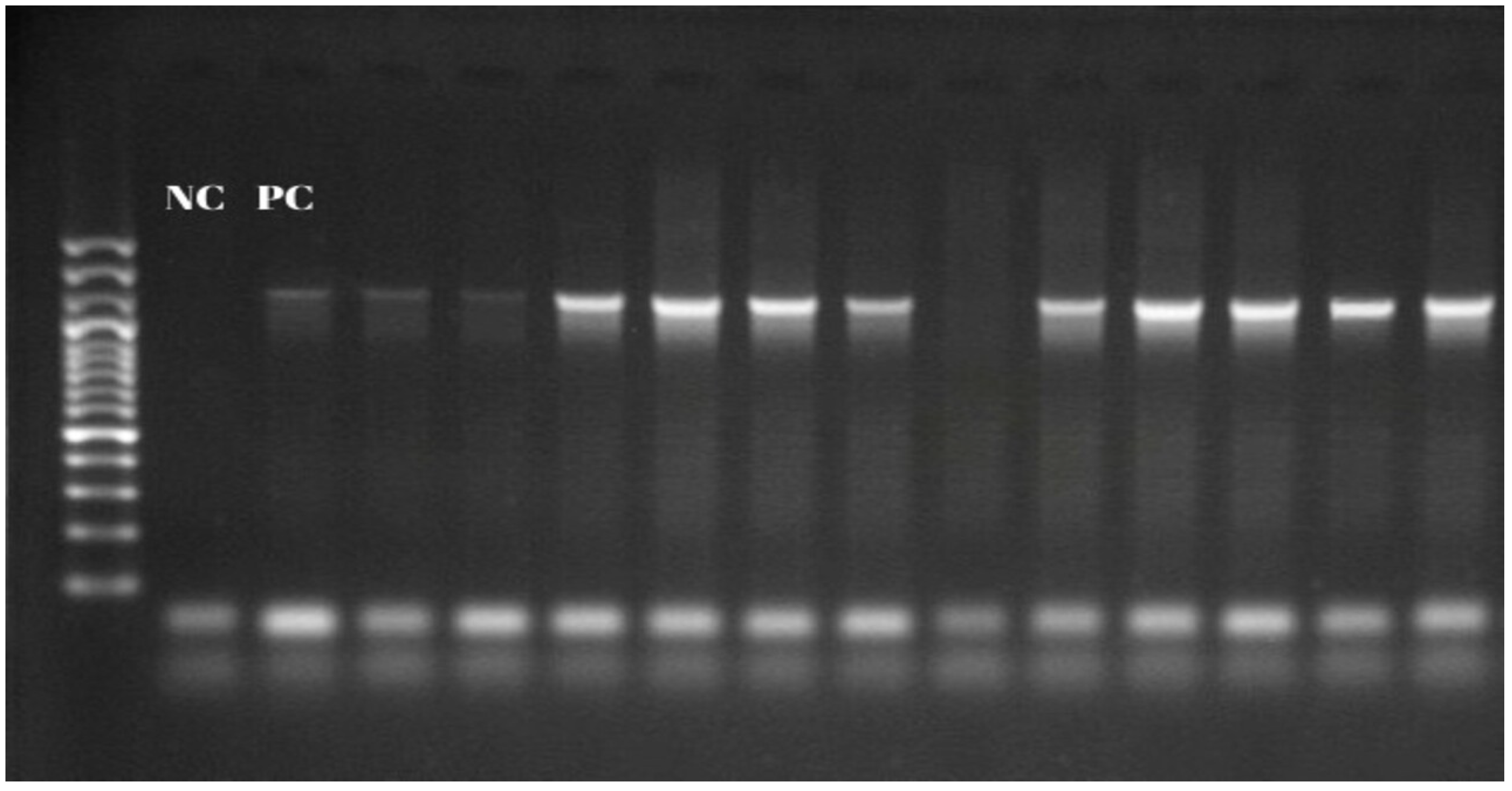
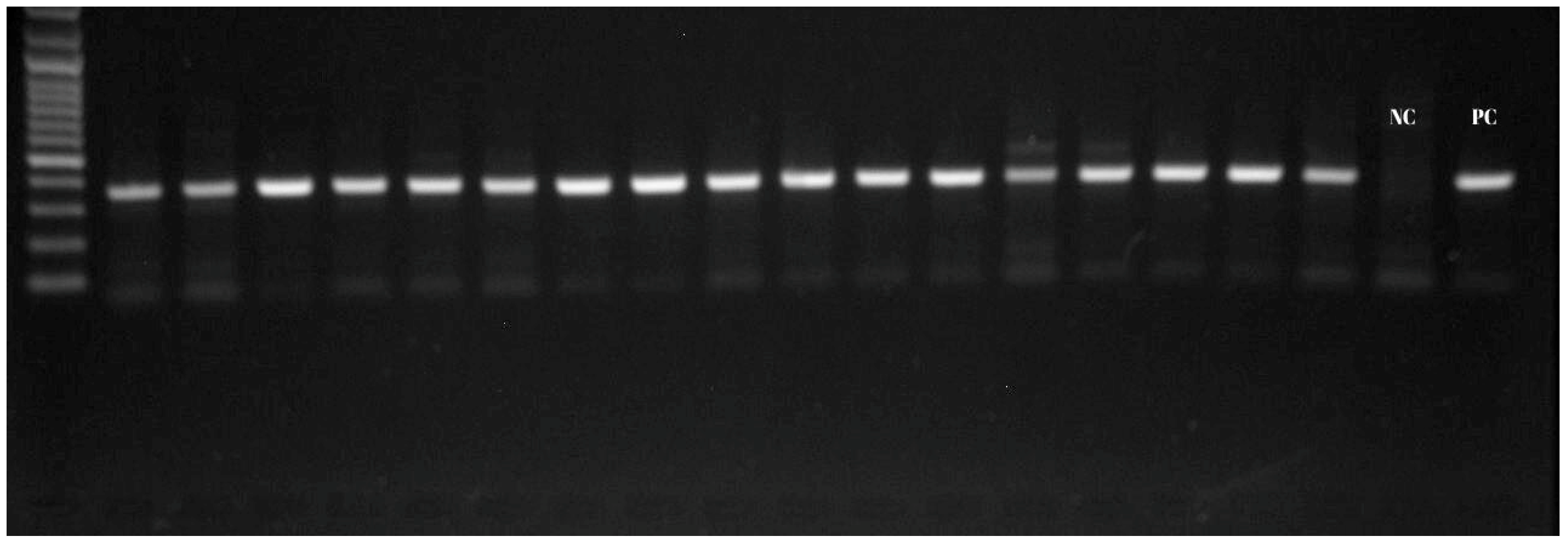
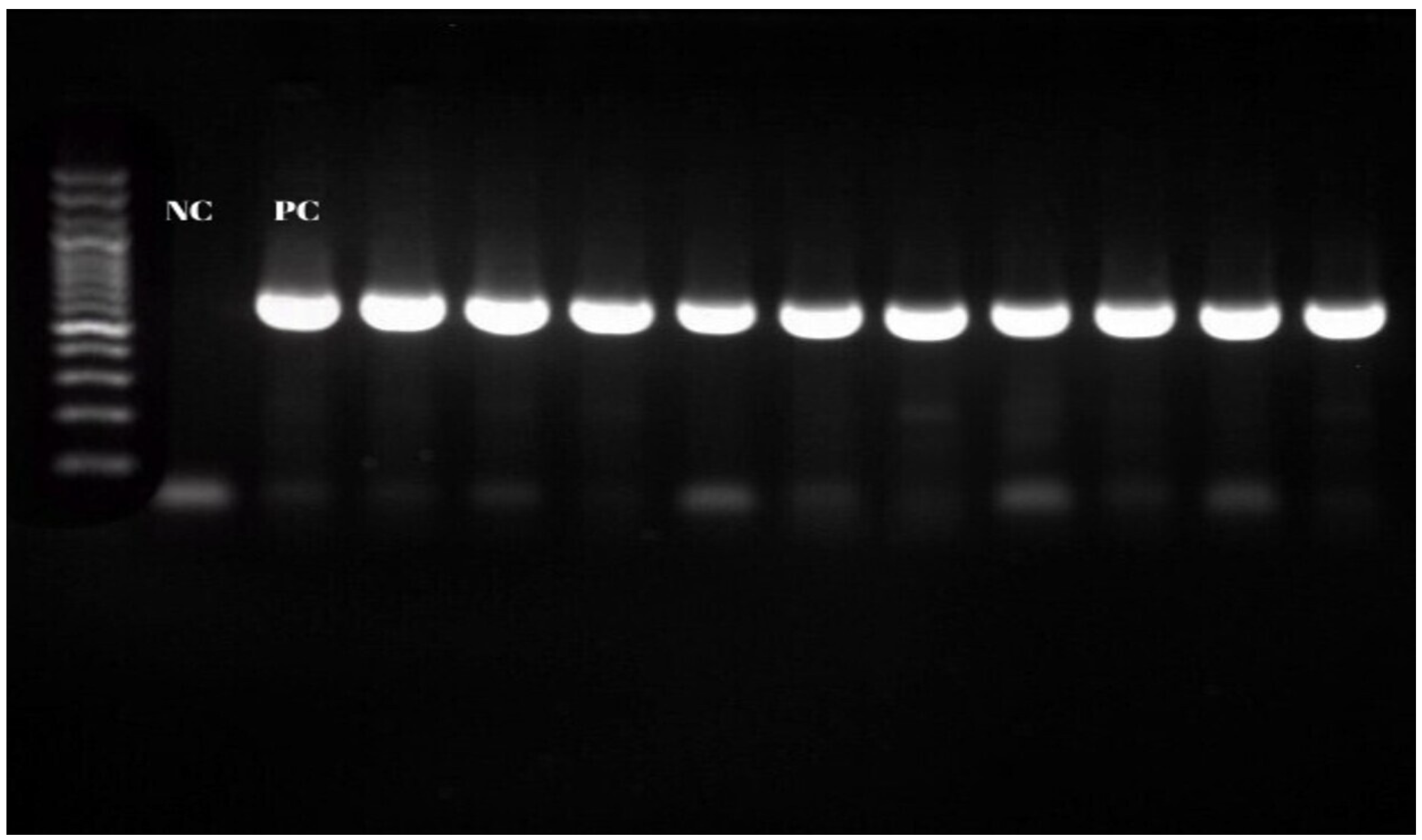
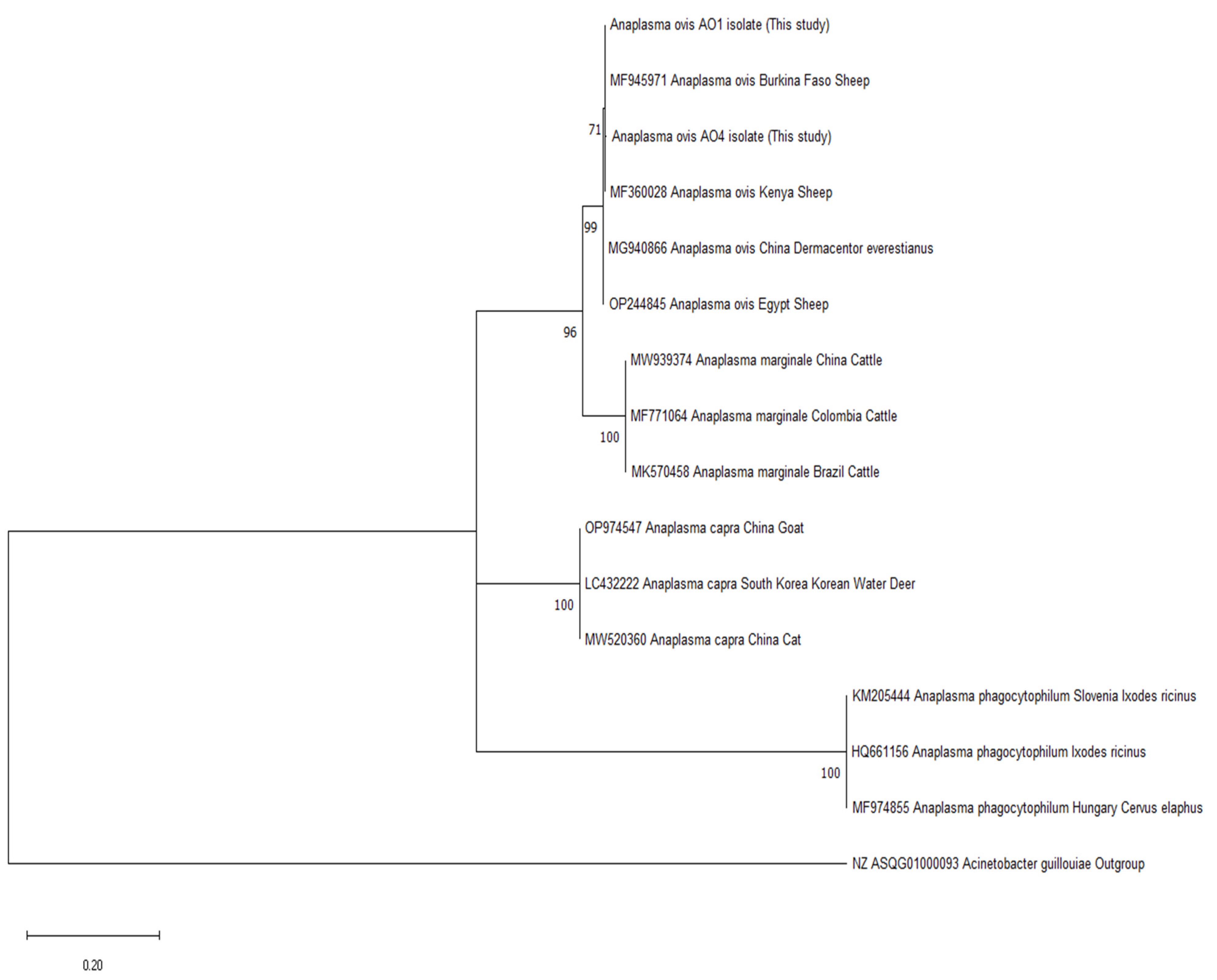
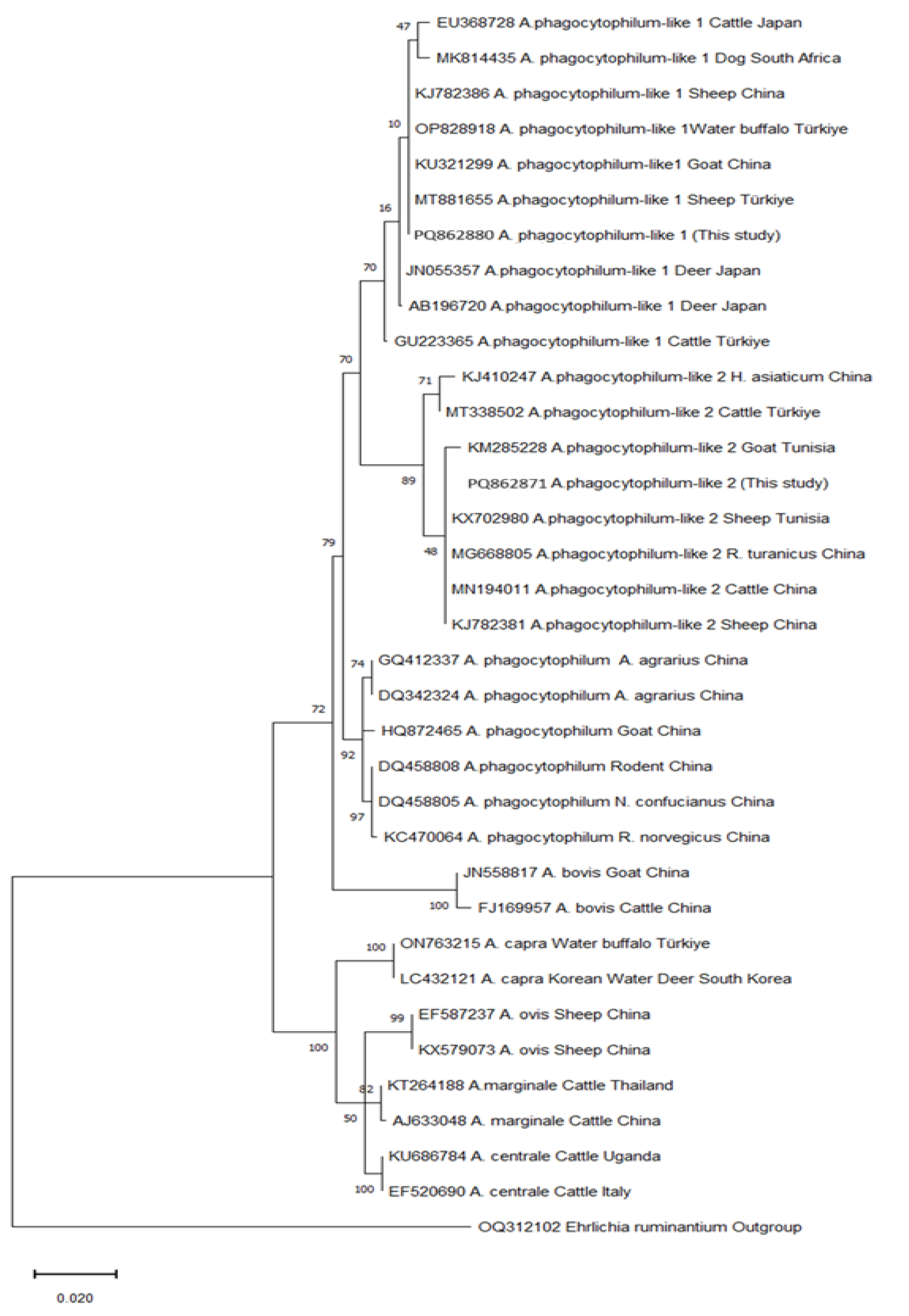
| Primer | Sequences | bp | Genus/Species |
|---|---|---|---|
| EC9 EC12A | 5′-TACCTTGTTACGACTT-3′ 5′-TGATCCTGGCTCAGAACGAACG-3′ | 1462 bp | Anaplasma/Ehrlichia |
| SSAP2F SSAP2R | 5′-GCTGAATGTGGGGATAATTTAT-3′ 5′-ATGGCTGCTTCCTTTCGGTTA-3′ | 641 bp | Anaplasma phagocytophilum |
| msp4F msp4R | 5′-TGAAGGGAGCGGGGTCATGGG-3′ 5′-GAGTAATTGCAGCCAGGCACTCT-3′ | 347bp | Anaplasma ovis |
| OuterF OuterR InnerF InnerR | 5′-GCGATTTTAGAGTGYGGAGATTG-3′ 5′-TACAATACCGGAGTAAAAGTCAA-3′ 5′-TCATCTCCTGTTGCACGGTGCCC-3′ 5′-CTCTGAATGAACATGCCCACCCT-3′ | 1031 bp 594 bp | Anaplasma capra |
| Age X2 = 1.969 p = 0.579 p > 0.05 | Positive | Negative | Total |
| ≤1 | 6 (10.9%) | 49 (89.1%) | 55 (100.0%) |
| 2–3 | 12 (16.2%) | 62 (83.8%) | 74 (100.0%) |
| 4–5 | 18 (18.75%) | 78 (81.25%) | 96 (100.0%) |
| >5 | 19 (13.6%) | 120 (86.4%) | 139 (100.0%) |
| Gender X2 = 0.563 p = 0.453 p > 0.05 | |||
| Female | 51(15.5%) | 277 (84.5%) | 328 (100.0%) |
| Male | 4 (11.1%) | 32 (88.9%) | 36 (100.0%) |
| Breed X2 = 9.054 p = 0.011 p < 0.05 | |||
| Turkish Hair goat | 43 (17.8%) | 198 (82.2%) | 241 (100.0%) |
| Aleppo goat | 10 (17.2%) | 48 (82.8%) | 58 (100.0%) |
| Others | 2 (3%) | 63 (97%) | 65 (100.0%) |
| Altitude X2 = 3.741 p = 0.154 p > 0.05 | |||
| 0–50 m | 18 (15.1%) | 101 (84.9%) | 119 (100.0%) |
| 50–500 m | 13 (10.65%) | 109 (89.35%) | 122 (100.0%) |
| >500 m | 24 (19.5%) | 99 (80.5%) | 123 (100.0%) |
| Districts | |||
| Ceyhan | 6 (20%) A. ovis (6) | 24 (80.0%) | 30 (100.0%) |
| Yumurtalık | 5 (20.8%) A. ovis (5) | 19 (79.2%) | 24 (100.0%) |
| Kozan | 1 (4.2%) A. ovis (1) | 23 (95.8%) | 24 (100.0%) |
| İmamoğlu | 6 (25%) A. ovis (6) | 18 (75%) | 24 (100.0%) |
| Sarıçam | 2 (7.4%) A. ovis (2) | 25 (92.6%) | 27 (100.0%) |
| Karataş | - | 12 (100.0%) | 12 (100.0%) |
| Yüreğir | 1 (4%) A. ovis (1) | 24 (96%) | 25 (100.0%) |
| Çukurova | - | 24 (100.0%) | 24 (100.0%) |
| Karaisalı | 4 (16.6%) A. ovis (4) | 20 (83.4%) | 24 (100.0%) |
| Saimbeyli | 1 (4%) A. ovis (1) | 24 (96%) | 25 (100.0%) |
| Tufanbeyli | 14 (58.3%) A. phagocytophilum (9) A. ovis (14) | 10 (41.7%) | 24 (100.0%) |
| Feke | - | 24 (100.0%) | 24 (100.0%) |
| Pozantı | 3 (11.5%) A. phagocytophilum (1) A. ovis (3) | 23 (88.5%) | 26 (100.0%) |
| Aladağ | 6 (24%) A. ovis (6) | 19 (76%) | 25 (100.0%) |
| Seyhan | 6 (23%) A. phagocytophilum (1) A. ovis (6) | 20 (77%) | 26 (100.0%) |
| Total | 55 (15.1%) | 309 (84.9%) | 364 (100.0%) |
| Genus/Species/N | GenBank Numbers | Nucleotide Substitution Localization | |||||||||||||||||
|---|---|---|---|---|---|---|---|---|---|---|---|---|---|---|---|---|---|---|---|
| Anaplasma spp. PCR-Positive 55 (15%) | A. ovis 55 (100%) | A. ovis genotype 1 (46 isolates) PQ878024–PQ878036 PQ878039–PQ878071 A. ovis genotype 2 (2 isolates) PQ878037, PQ878038 | GenBank Accession Numbers | Country | Host | msp4 Nucleotide Positions | |||||||||||||
| 188 | |||||||||||||||||||
| PQ878024 ** | TR | Goat | T | ||||||||||||||||
| PQ878037 ** | TR | Goat | C | ||||||||||||||||
| MF945971 | BF | Sheep | T | ||||||||||||||||
| MF360028 | KE | Sheep | T | ||||||||||||||||
| A. phagocytophilum 11 (20%) | A. phagocytophilum-like 1 PQ862872–PQ862880 (9 isolates) | GenBank Accession Numbers | Country | Host | 16S rRNA Nucleotide Positions | ||||||||||||||
| 976 | 997 | 1095 | 1099 | 1106 | 1124 | 1134 | 1223 | 1225 | 1226 | 1228 | 1245 | 1277 | 1402 | ||||||
| PQ862877 ** | TR | Goat | G | A | G | T | C | C | T | T | T | C | C | G | C | C | |||
| OP828918 | TR | W.Buf | * | * | * | * | * | * | * | * | * | * | * | * | * | * | |||
| KJ782386 | CN | Sheep | * | * | * | * | * | * | * | * | * | * | * | * | * | * | |||
| KU321299 | CN | Goat | * | * | * | * | * | * | * | * | * | * | * | * | * | * | |||
| MT881655 | TR | Sheep | * | * | * | * | * | * | * | * | * | * | * | * | * | * | |||
| A. phagocytophilum-like 2 PQ862871 (1 isolate) | PQ862871 ** | TR | Goat | * | G | * | * | T | * | C | C | C | T | * | A | T | * | ||
| MG668805 | CN | Tick | * | G | * | * | T | * | C | C | C | T | * | A | T | * | |||
| MN194011 | CN | Cattle | * | G | * | * | T | * | C | C | C | T | * | A | T | * | |||
| KX702980 | TN | Sheep | * | G | * | * | T | * | C | C | C | T | * | A | T | * | |||
| KJ782381 | CN | Sheep | * | G | * | * | T | * | C | C | C | T | * | A | T | * | |||
Disclaimer/Publisher’s Note: The statements, opinions and data contained in all publications are solely those of the individual author(s) and contributor(s) and not of MDPI and/or the editor(s). MDPI and/or the editor(s) disclaim responsibility for any injury to people or property resulting from any ideas, methods, instructions or products referred to in the content. |
© 2025 by the authors. Licensee MDPI, Basel, Switzerland. This article is an open access article distributed under the terms and conditions of the Creative Commons Attribution (CC BY) license (https://creativecommons.org/licenses/by/4.0/).
Share and Cite
Gökmen, T.G.; Ütük, A.E.; Tokgöz, E.A.; Uprak, N.S.; Tekin, A.S.; Erol, U.; Demir, P.A.; Sezer, O.; Günaydın, E. Molecular Prevalence and Phylogenetic Analysis of Anaplasma spp. in Goats from Adana, Türkiye. Vet. Sci. 2025, 12, 481. https://doi.org/10.3390/vetsci12050481
Gökmen TG, Ütük AE, Tokgöz EA, Uprak NS, Tekin AS, Erol U, Demir PA, Sezer O, Günaydın E. Molecular Prevalence and Phylogenetic Analysis of Anaplasma spp. in Goats from Adana, Türkiye. Veterinary Sciences. 2025; 12(5):481. https://doi.org/10.3390/vetsci12050481
Chicago/Turabian StyleGökmen, Tülin Güven, Armağan Erdem Ütük, Esra Aslan Tokgöz, Nur Sima Uprak, Afra Sena Tekin, Ufuk Erol, Pınar Ayvazoğlu Demir, Osman Sezer, and Elçin Günaydın. 2025. "Molecular Prevalence and Phylogenetic Analysis of Anaplasma spp. in Goats from Adana, Türkiye" Veterinary Sciences 12, no. 5: 481. https://doi.org/10.3390/vetsci12050481
APA StyleGökmen, T. G., Ütük, A. E., Tokgöz, E. A., Uprak, N. S., Tekin, A. S., Erol, U., Demir, P. A., Sezer, O., & Günaydın, E. (2025). Molecular Prevalence and Phylogenetic Analysis of Anaplasma spp. in Goats from Adana, Türkiye. Veterinary Sciences, 12(5), 481. https://doi.org/10.3390/vetsci12050481





